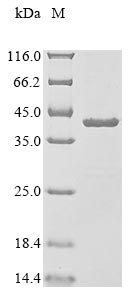Purity
Greater than 85% as determined by SDS-PAGE.
Alternative Names
ATP synthase F1 subunit gamma (F-ATPase gamma subunit)
Species
Homo sapiens (Human)
Expression Region
26-298aa
Target Protein Sequence
ATLKDITRRLKSIKNIQKITKSMKMVAAAKYARAERELKPARIYGLGSLALYEKADIKGPEDKKKHLLIGVSSDRGLCGAIHSSIAKQMKSEVATLTAAGKEVMLVGIGDKIRGILYRTHSDQFLVAFKEVGRKPPTFGDASVIALELLNSGYEFDEGSIIFNKFRSVISYKTEEKPIFSLNTVASADSMSIYDDIDADVLQNYQEYNLANIIYYSLKESTTSEQSARMTAMDNASKNASEMIDKLTLTFNRTRQAVITKELIEIISGAAALD
Note: The complete sequence including tag
sequence, target protein sequence and linker sequence could be provided upon request.
Protein Length
Full Length of Mature Protein
Tag Info
N-terminal 10xHis-tagged and C-terminal Myc-tagged
Form
Liquid or Lyophilized powder
Note: We will preferentially ship the format that
we have in stock, however, if you have any special requirement for the format, please remark your
requirement when placing the order, we will prepare according to your demand.
Buffer
If the delivery form is liquid, the default storage buffer is Tris/PBS-based buffer, 5%-50% glycerol.If the delivery form is lyophilized powder, the buffer before lyophilization is Tris/PBS-based buffer, 6% Trehalose, pH 8.0.
Reconstitution
We recommend that this vial be briefly centrifuged prior to opening to bring the contents to the bottom. Please reconstitute protein in deionized sterile water to a concentration of 0.1-1.0 mg/mL.We recommend to add 5-50% of glycerol (final concentration) and aliquot for long-term storage at -20°C/-80°C. Our default final concentration of glycerol is 50%. Customers could use it as reference.
Storage Condition
Store at -20°C/-80°C upon receipt, aliquoting is necessary for mutiple use. Avoid repeated freeze-thaw
cycles.
Shelf Life
The shelf life is related to many factors, storage state, buffer ingredients, storage temperature
and the stability of the protein itself.
Generally, the shelf life of liquid form is 6 months at -20°C/-80°C. The shelf life of lyophilized
form is 12 months at -20°C/-80°C.
Lead Time
3-7 business days
Notes
Repeated freezing and thawing is not recommended. Store working aliquots at 4°C for up to one week.
Datasheet & COA
Please contact us to get it.
Description
In the production of the recombinant Human ATP5F1C protein in e.coli cells, a sequential pipeline involves constructing the expression vector coding for the Human ATP5F1C protein (26-298aa), transforming the recombinant vector into e.coli cells, selecting the positive cells and cultivating them, lysing cells, and characterizing the protein. The resulting recombinant Human ATP5F1C protein is purified from the cell lysate using affinity purification. Its purity exceeds 85%, as determined by SDS-PAGE.







